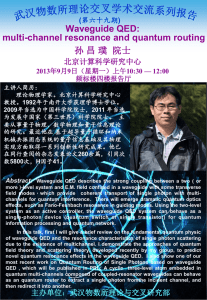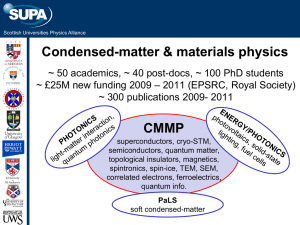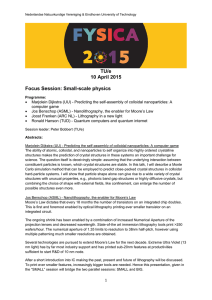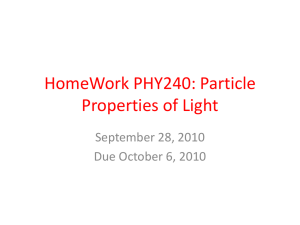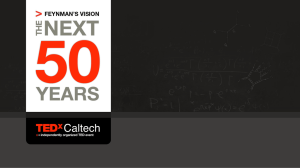Quantum information, topological invariants and formal
advertisement
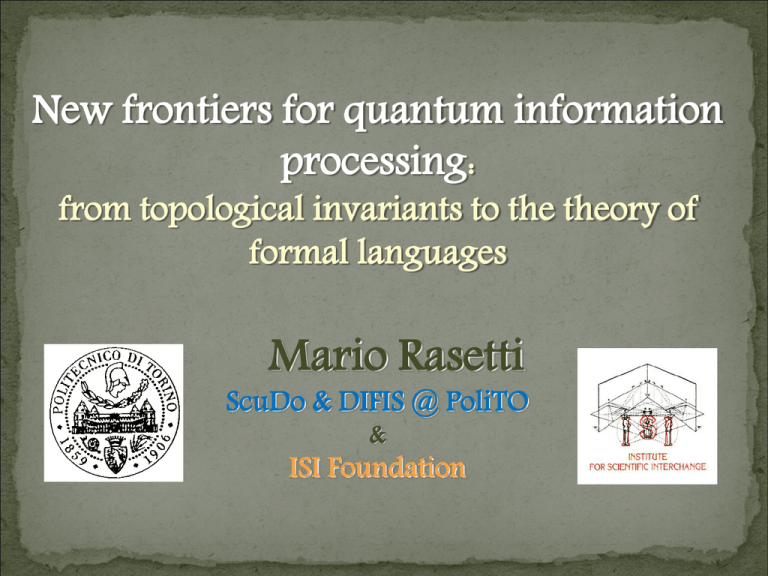
New frontiers for quantum information
processing:
from topological invariants to the theory of
formal languages
Mario Rasetti
ScuDo & DIFIS @ PoliTO
&
ISI Foundation
Algorithmic complexity:
the central open problem in computer science is
the conjecture whether the two complexity
classes P (polynomial) and NP (non-deterministic
polynomial; i.e. those decision problems for
which a conjectured solution can be verified in
polynomial time) are distinct or not within the
standard Turing model of computation:
P NP
?
It is by now generally assumed that each physical
theory supports computation models whose
power is limited by the physical theory itself.
Classical physics, quantum mechanics and
topological quantum field theory (TQFT) are
believed to support a multitude of different
implementations of the Turing machine (or
equivalent: boolean circuits, automata) model of
computation.
There is a conceptual dilemma here: whether
i) an abstract universal model of computation,
able to simulate any discrete quantum system,
including solvable topological field theories,
exists on its own
or
ii) any quantum system is by itself a computing
machine whose internal evolution can reproduce
the proper dynamics of a class of physical
systems.
The capability of quantum information theory of
efficiently computing topological or geometric
quantities was first conjectured by Michael
Freedman and co-workers.
Their 'topological quantum computation' setting,
is designed to comply with the behavior of
'modular functors' of Chern-Simons-Witten 3-D
non-abelian topological quantum field theory,
with gauge group SU(2).
In physicists’ language, functors are partition
functions and correlators of the quantum
theory; in view of gauge invariance and
invariance under diffeomorphisms, which
freeze out local degrees of freedom, they share
a global, 'topological' character.
The term "topological quantum field theory" is used
to refer to two distinct but related concepts: i) any
quantum field theory in which the action is
diffeomorphism invariant (the best known example
is Chern-Simons theory); ii) any structure satisfying
the Atiyah axioms.
The two concepts are not unrelated. The matrix
elements of the linear transformation corresponding
to a cobordism are analogous to the transition
amplitudes that one would compute by path
integral in a conventional formulations of quantum
field theory.
A universal model of computation, capable of
solving (in the additive approximation) # P
problems in polynomial time stems out of a
discrete, finite version of a non-Abelian TQFT
with Chern-Simons action
It can be thought of as an analog computer able
to solve a variety of hard problems in Topology
(knots and manifolds invariants), in Formal
Language Theory and perhaps in Life Science.
A n-dimensional axiomatic topological quantum
field theory (TQFT) is a map that associates a
Hilbert space to any (n-1)-manifold, and to any
n-dimensional manifold "interpolating" between
a pair of (n-1)-dimensional manifolds, and
associates a linear transformation between the
corresponding Hilbert spaces: cobordism, defined
as a triple (M,A,B) where M is an n-manifold
whose boundary is the disjoint union of (n-1)manifolds A and B. This provides the notion of
interpolation between A and B.
For example, the circle S1 is a 1-manifold, and a
tube S1 × [0, 1] is a cobordism between two circles.
A 2-dimensional TQFT associates a Hilbert space
H S1 to S1 and a linear transformation M0 the tube
A different cobordism between the same pair of
boundaries may be mapped to a different linear
transformation between the same pair of Hilbert
spaces
If we compose two cobordisms, we compose the
corresponding linear transformations.
Mathematicians express this propert saying that a
TQFT is a "functor". The linear transformation
associated to a cobordism by a TQFT depends only
on the topology of the cobordism, not the
geometric details.
For example, M0 ◦ M0 = M0. To the empty
boundary we associate the Hilbert space C. We
can think of a closed manifold as a cobordism
between and . Therefore an n-dimensional
TQFT associates to any closed n-manifold a map
from C to C, that is, a complex number. Such map
is a C-valued topological invariant of closed nmanifolds.
Renormalization (Wilson;1970):
How does the Langrangian evolve when reexpressed using longer and longer length scales,
i.e., lower frequencies, colder temperatures ?
The terms with the fewest derivatives dominate
because in momentum space, differentiation
becomes multiplication by k and: k >> k 2
Chern-Simons Action has one derivative:
A d A + 2/3 (A A A)
2
while kinetic energy p /2m is written with
two derivatives (p = - i /h d/dx)
Thus, in condensed matter at low enough
temperatures,
we may expect
to see systems
in which the
topological
effects dominate
and geometric detail becomes irrelevant.
Knots : what are they ?
Knots
Knots are equivalence classes
with respect to isotopies
Central problem knot theory is classification of
knots : given two knots decide whether or not
they are topologically equivalent.
Classification is made by invariants in the form
of polynomials, whose coefficients encode the
topological properties of a class of knots (Jones,
Alexander, etc.)
The JP for
the trefoil knot
Complexity
To evaluate the Jones polynomial is a #P-hard
problem from the computational point of view
There exist no efficient classical algorithms for
its evaluation
Jaeger, Vertigan and Welsh,
On the computational complexity of the Jones and Tutte Polynomials,
Mathematical Proceedings of the Cambridge Phil. Soc. 108(1990), 35-53
Manifolds :
What are they ?
Manifolds are spaces every point of which
has a neighbourhood homeomorphic to a
Euclidean space
The most general property of 3-manifolds
is the "prime decomposition" :
every compact orientable 3-manifold M
decomposes uniquely as a connected sum
M = P1 # # Pn of 3-manifolds Pi which
are prime in the sense that they can be
decomposed as connected sums only in the
trivial way Pi = Pi # S3
Prime Manifolds
Standard topological invariants were created in
order to distinguish between things: it is their
intrinsic definition that makes clear what kind of
properties they reflect, e.g., the Euler number χ of
a smooth, closed, oriented surface S defined as
χ(S) = 2 − 2g,
where genus g is the number of handles of S, fully
determines its topological type.
[ χ can be evaluated upon tessellation by Euler’s
formula χ(S) = V + F – E ; V= # Vertices ; F = #
Faces ; E = # Edges ]
On the contrary, Quantum Invariants of knots
and three-manifolds were instead discovered,
yet their indirect construction, based as it is on
quantum technology, provides information
about the purely topological properties we
were unable to detect, even to hint.
Beyond prime decomposition, 3-manifolds
admit as well a canonical decomposition along
tori rather than spheres.
Homeomorphism invariants of 3-manifolds
are the isotopy invariants of Knots and Links
(invariants of homology cobordism)
(George K Francis)
Formal languages: what are they ?
The basic ingredient of a language
is its alphabet A. An alphabet is a
finite set of symbols.
A language L is a sequence of finite
sequences of symbols over the alphabet A (words).
All sequences in a language are finite, yet the
language itself can be infinite. Any non-empty set
of languages over finite alphabets defines a family
of languages.
Many families of formal languages
are known, including the four
families of the Chomsky Hierarchy
(regular sets, context-free languages,
context sensitive languages and
recursively enumerable sets), recursive sets, and
indexed languages. rigorous formal (group
theoretical) setting of context-free languages and
of formal language theory.
Any formal language can be
reconducted to a machine
which recognizes it:
regular sets are recognized by finite state
automata,
context-free languages are recognized by
(non- deterministic) pushdown automata,
recursively enumerable and recursive sets
respectively, are recognized by Turing
machines and halting Turing machines.
Alternatively, a formal language may be
generated (i.e., defined) by the set of its
grammatical rules, as it is the case for
indexed languages, recognized by one way
nested stack automata, and generated by
grammars.
Spin Network
Quantum Simulator
The spin network quantum simulator model
bridges circuit schemes of quantum
computation with TQFT.
Its key tool is the "fibered graph-space"
structure underlying it, which exhibits
combinatorial properties related to SU(2)
[SU(2)q] state sum models.
Spin Network
Quantum Simulator
Spin Network Quantum Simulator
Hilbert spaces
Alphabet and Words
and Quantum Codes
Gn (V, E)
Spin Network Quantum Simulator
Racah
bracketing
words
relations
Biedenharn
Elliott
The two most important properties of 6j-symbols
are their tetrahedral symmetry and the ElliottBiedenharn or pentagon identity.
The tetrahedral symmetry is an equivariance
property under permutation of the six labels,
summarized by the labeled Mercedes badge:
Spin Network Quantum Simulator
The Elliott-Biedenharn identity expresses the fact that the
composition of five successive change-of-basis operators inside
a space of 5-linear invariants is the identity.
( N.B. Cfr. Mapping Class Group – Hatcher & Thurston )
Ponzano-Regge approximation associates linear
transformations to 3-manifolds, thought of as
cobordisms between 2-manifolds. Among the ways
of describing 3-manifolds, the most intuitive is by
triangulation: a prescription of tetrahedra and of
which face is "glued" to which.
For example, we could take two tetrahedra and
glue their faces:
(the 6j symbol is invariant under the 24
symmetries of the tetrahedron)
Pachner’s moves
Pachner’s theorem
Two triangulations specify the same 3-manifold if
and only if they are connected by a finite sequence
of the 2-3 and 1-4 moves and their inverses
In the Ponzano-Regge model, given a triangulated
3-manifold one associates one j-variable to each
edge of each tetrahedron. j-variables represent
quantum spins and take integer and half-integer
values. To a closed manifold the Ponzano-Regge
model associates the amplitude :
Notice that the 6j symbol is invariant under the 6!
= 24 symmetries of the spin tetrahedron
Asymptotics (semiclassical limit: very large spins)
conditions: a ≤ b + c ; b ≤ c + a ; c ≤ a + b ; a + b + c = even
associate to the six labels a, b, . . . f a metric tetra
-hedron τ with these as side lengths.
conditions guarantee that the individual faces
may be realized in Euclidean 2-space. τ has an
isometric embedding into Euclidean or
Minkowskian 3-space according to the sign of
the Cayley determinant. If τ is Euclidean, let θa,
θb, . . . , θf be its corresponding exterior dihedral
angles and V its volume.
(Wigner)
For k → ∞ (for k ∈ Z) there is an asymptotic
formula
For a three-dimensional quantum field theory on
triangulated manifolds to be topological, it
should be independent of triangulation, that is,
invariant under the Pachner moves.
N.B.: the Ponzano-Regge model fails to be fully
topological in general, as it is invariant only
under the 2-3 Pachner move as a consequence
of the Beidenharn-Elliot identity for 6j symbols
H13(V)
SNQS
the computational
graph G 3 (V, E)
G3 (V, E)
Fiber space structure of the spin network simulator for 4 spins. Vertices and edges on
the perimeter of the graph G3 (V, E) have to be identified through the antipodal map.
The “blown up” vertex shows the local computational Hilbert space.
SNQS
State transformations
Quantum amplitudes:
(s-cl : Feynman path sum)
From the Spin Network
Quantum Simulator to the Spin
Network Quantum Automaton
Cobordims & pant decomposition
pants
SNQA is defined by the 5-tuple
and therefore can be thought of as a quantum
recognizer (Wiesner and Crutchfield )
A quantum recognizer is a particular type of finite-states quantum
machine defined as a 5-tuple
{Q, H, X, Y, T( Y|X )},
Q is a set of basis states, the internal states of the machine;
H is a Hilbert space in which a particular (normalized) state,
| H is singled out as ''start state'' expressed in the basis Q;
X and Y { a, r, } (a accept , r reject , the null symbol)
are finite alphabets for input and output symbols respectively;
T( Y|X ) is the subset of transition matrices.
These general axioms can be adapted to make the
machine able to recognize a language L endowed
with a word-probability distribution p(w) over
the set of words {w} L .
For any w=x y z L the recognizer one-step
transition matrix elements are obtained by
reading each individual symbol in w.
The recognizer upgrades the start state to
U (w) | U(z) U (y) U (x) |.
The Spin Network Quantum Automaton
as Quantum Recognizer
The Spin Network Quantum Automaton (SNQA) is
the quantum finite-state machine generated by
deformation of the Spin Network Quantum
Simulator structure algebra (su(2)q instead of
su(2)).
With this assumption SNQA recognizes the
language of the Braid Group.
From the Spin Network Quantum Simulator
to the Spin Network Quantum Automaton
The Braid Group
elements
composition
identity
inverse
Generators
&
Relations
The additive approximation:
if a quantum circuit of dimension O(poly(n))
operates over n qubits, and if is a pure state
of n qubits which can be prepared in O(poly(n))
time, then it is possible to construct a statistical
ensemble in which, sampling for a O(poly(n))
time two random variables X, Y one has
E[X+iY]=|U|
Quantum Computation Tools
The formal definition of the Jones polynomial J(q)
is given in terms of: a trace of the braid group
representation into the Temperley Lieb algebra
J(q) = (– A)
-3w(L)
d
n–1
Trr (s)
[ Let R be a commutative ring and λ R. The Temperley-Lieb algebra Ln (λ) is
the Hecke R-algebra generated by elements U1U2 … Un-1, subject to relations :
Ui Ui = λ Ui for all 1 i n-1
UiUi + 1Ui = Ui for all 1 i n-2
UiUi − 1Ui = Ui for all 2 i n-1
UiUj = UjUi
for all 1 i,j n-1 such that |i – j| 1 ]
here:
r is a representation of the braid group Bn in Ln
-1
with coefficients in c [ q , q ] and parameter
-1
2
-2
d = - q - q , such that s q U + q I , and
w (L) is the writhe number f or link L ,
V.F.R. Jones, A polynomial invariant for links via von
Neumann algebras, Bull. Amer. Math. Soc. 129 (1985),
103-112.
Knot-braid connection
A given
link L
L (coloured)
can always be seen as the closure of a braid
(Alexander theorem)
The standard closure of a braid
pattern inside a 3-manifold
The plat-closure of a
braid inside a 3-manifold
Use CS-TQFT exact solution, through a unitary
representation of the braid group:
given a knot present it as a closure of a braid
cut the braid with horizontal lines so that between
two lines there is at most one crossing
use the unitary representation of the braid group to
evaluate the (conformal) topological invariant
R. Kaul, Chern-Simons theory, colored-oriented braids and links
invariants, Comm. In Math.Phys. 162(1994), 289
The circuit
Complexity
# gates n poly (k)
# qubits n log (k+1)
n = index of the braid group Bn
Measuring auxiliary
qubit entangled with
the system one can
obtain an approximate
efficient evaluation of
the Jones polynomial .
Modular functions
(theta functions
coherent states)
A typical fundamental domain for the action
of the modular group on the upper half-plane
(2 + 1) (2 + 6)
[ mod 14]
Modular Group
The braid group B3 is the universal
central extension of the modular group
Application to formal language theory
A metaphorical and exhaustive study-case for all
above notions is the efficient solution of Dehn’s word
problem for the Dehornoy group B (which includes
braid and Thompson's groups). Its presentation
extends the standard presentations of both, starting
from a geometric approach according to which the
elements of B can be seen as parenthesized braids.
Every element of B generates a free subsystem with
respect to the bracketing (self-distribuive) operation
(x(yz)) = ((xy)(xz))
The trefoil knot :
parenthesized
quantum
presentation
Conclusions and perspectives
Quantum symbolic manipulation
Quantum (artificial) Intelligence
Emergence of structures in languages
what next ?
Origin of Life: molecules as message passers
With photosynthesis, cyanobacteria are able
to transfer sunlight energy to molecular
reaction centers for conversion into chemical
energy with 100% efficiency. Speed is the
key: transfer of solar energy (single photons)
takes place almost instantaneously so little
energy is wasted as heat.
The green sulfur bacterium
Quantum coherence influences energy transfer
in photosynthesis; when it hits the bacterial
protein, the light energizes a series of reactions
that ultimately lead the protein to emit light of
its own. Individual electrons coordinate their
movements ("entanglement" ??) as they jostle
energy back and forth: shifts to the left or right
make electrons connect, while vertical shifts
imply energy being passed or received.
The two crucial questions in developmental
biology are:
how does one tell when there is
communication in living systems?
how does developmental control depend
on the meaning of communication?
A better comprehension is required of the
processes whereby molecules can function
symbolically, i.e., as records, codes (messages)
and signals.
One seeks to know how a molecule can and
does become a message; answering the
question: what is the simplest set of physical
conditions that would allow matter to branch
into two pathways – the living and lifeless – but
under a single set of microscopic dynamical
laws?
And how large (complex) a system
one must consider before biological
function has a meaning?
Know how to distinguish communication
between molecules from physical interactions
between molecules.
Make such distinction at the simplest possible
level, since the answer to the basic question
about the origin of life cannot come from highly
evolved organisms, in which communication
processes are clear, distinct and complex.
The crucial question is to know how
messages originated.
The alphabet:
{A,C,G,T}
A molecule does not become a message because of
any particular shape or structure or behaviour of
the molecule itself. A molecule becomes a message
only in the context of a larger system of physical
constraints, that can be thought of as a "language".
Aim to a higher level than that of conventional
quantum physics: not molecular structures only
but the structure of language which they mutually
communicate with.
Spin Network Quantum Automaton
can possibly provide an answer!!
Hereditary processes are crucial: biology asserts
that the mystery of heredity is solved at the
molecular level by the structure of DNA and the
laws of chemistry.
Current molecular biological interpretation of
hereditary transmission begins with DNA which
replicates by a "template" process and then passes
its hereditary information to RNA, which in turn
codes the synthesis of the proteins. Proteins
function primarily as (enzyme) catalysts.
Thus the "central dogma" of biology asserts that
hereditary information passes from the nucleic
acids to the proteins, and never the other way
around: for this reason
the most primitive
hereditary reactions
at the origin of life
plausibly occur in
template replicating
nucleic acid molecules.
The crucial logical point is here that the
hereditary propagation of a trait, involving a
code as it does, implies a classification process
and not simply the operation of the physical laws
of motion on a set of initial conditions. Such
dynamical laws depend only on the immediate
past whereas only through the notion of a
physical system able to manipulate information
one can associate the concept of memory,
description, code and classification. In this
complex framework quantum correlations must
be recognized as relevant.



